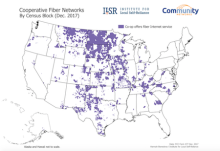Cooperatives Fiberize Rural America: A Trusted Model For The Internet Era (Updated 2019)

Decades after bringing electricity and telephone services to America’s rural households, cooperatives are tackling a new challenge: the rural digital divide. New updates to our report Cooperatives Fiberize Rural America: A Trusted Model for the Internet Era, originally published in 2017, illustrate the remarkable progress co-ops have made in deploying fiber optic Internet access across the country.
Download the updated report [PDF] here.
All versions of the report can be accessed from the Reports Archive for this report.
The report features new maps showing overall growth in areas served by co-ops, as well as expanded information about state legislation that supports co-op investment in broadband networks. A few important takeaways:
More than 140 co-ops across the country now offer residential gigabit Internet access to their members, reaching more than 300 communities.
Co-ops connect 70.8 percent of North Dakota and 47.7 percent of South Dakota landmass to fiber, and residents enjoy some of the fastest Internet access speeds in the nation.
Georgia and Mississippi have overturned state laws banning co-ops from offering Internet access, and other states, including Colorado, Maryland, North Carolina, and Texas, have implemented legislation that will further ease the way.
Co-ops have proven that this is a model that works. With increased support from federal and state governments, they will continue to connect rural Americans to economic and educational opportunities otherwise denied to them.
Read Cooperatives Fiberize Rural America: A Trusted Model For The Internet Era [PDF] here.



